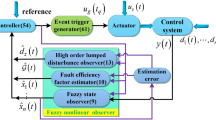Abstract
This paper proposes the fault detection filter for wireless sensor network. The problem of time-varying nonlinear filter is causing randomly varying nonlinearity due to environment, quantization error and packet dropout are solved by combining Bernoulli distributed white sequence and Robotics based Type-2 T–S (Takagi–Sugeno) Fuzzy method by taking output from sensor and neighbor sensor by solving recursive linear matrix inequalities. The random link failure and uncertainty caused by measurement missing and stochastic communication failure so it can be solved by Interval Type-2 T–S Fuzzy Method Systems (IT-2 T–S FMS) with robotics by closing the feedback loop and Lypunov theory asymptotically stable and satisfying average performance level. The filters are designed for a total defect detection system with a robust mean-square asymptotic stability. So these filters are used in the truck–trailer system for practical output.







Similar content being viewed by others
References
Babaie S, Shojaiy MG (2010) Improving fault management using voting mechanism in wireless sensor networks. In: 2010 International conference on computational intelligence and communication networks. IEEE, pp 359–362
Baskar S, Periyanayagi S, Shakeel PM, Dhulipala VS (2019) An energy persistent range-dependent regulated transmission communication model for vehicular network applications. Comput Netw. https://doi.org/10.1016/j.comnet.2019.01.027
Bernard M, Kondak K, Maza I, Ollero A (2011) Autonomous transportation and deployment with aerial robots for search and rescue missions. J Field Robot 28(6):914–931
Dong H, Wang Z, Gao H (2012) Fault detection for Markovian jump systems with sensor saturations and randomly varying nonlinearities. IEEE Trans Circuits Syst I Regul Pap 59(10):2354–2362
El-Alfy ES, Binsaadoon AG (2019) Automated gait-based gender identification using fuzzy local binary patterns with tuned parameters. J Ambient Intell Humaniz Comput 10(7):2495–2504
Gao Z, Cecati C, Ding SX (2015) A survey of fault diagnosis and fault-tolerant techniques—Part I: fault diagnosis with model-based and signal-based approaches. IEEE Trans Ind Electron 62(6):3757–3767
He X, Wang Z, Ji YD, Zhou DH (2011) Robust fault detection for networked systems with distributed sensors. IEEE Trans Aerosp Electron Syst 47(1):166–177
Janarthanan R, Konar A, Chakraborty A (2017) Propositional syntax and semantics induced knowledge re-structuring in a fuzzy logic network for ad hoc reasoning. Int J Approx Reason 82(1):138–160
Janarthanan R, Chakraborty A, Konar A, Nagar AK (2013) Ad hoc reasoning in chained fuzzy systems realized with Diens–Rescher implication. In: Proceedings of Fuzz-IEEE, 2013, pp 01–06
Katiyar M, Sinha HP, Gupta D (2012) On reliability modeling in wireless sensor networks—a review. Int J Comput Sci Issues (IJCSI) 9(6):99
Koziy K, Gou B, Aslakson J (2013) A low-cost power-quality meter with series arc-fault detection capability for smart grid. IEEE Trans Power Deliv 28(3):1584–1591
Li H, Gao Y, Shi P, Lam HK (2015) Observer-based fault detection for nonlinear systems with sensor fault and limited communication capacity. IEEE Trans Autom Control 61(9):2745–2751
Li T, Zheng WX (2015) Networked-based generalised H∞ fault detection filtering for sensor faults. Int J Syst Sci 46(5):831–840
Li X, Lille I, Falcon R, Nayak A, Stojmenovic I (2012) Servicing wireless sensor networks by mobile robots. IEEE Commun Mag 50(7):147–154
Liu J, Yue D (2013) Event-based fault detection for networked systems with communication delay and nonlinear perturbation. J Franklin Inst 350(9):2791–2807
Luo Y, Wang Z, Wei G, Alsaadi FE (2016) H∞ fuzzy fault detection for uncertain 2-D systems under round-robin scheduling protocol. IEEE Trans Syst Man Cybern Syst 47(8):2172–2184
Matin MA, Islam MM (2012) Overview of wireless sensor network. In: Matin MA (ed) Wireless sensor networks—technology and protocols. IntechOpen. https://doi.org/10.5772/49376
Mendel JM (2001) Uncertain rule-based fuzzy logic systems: introduction and new directions. Prentice-Hall, Upper Saddle River
Mohamed N, Al-Jaroodi J, Jawhar I (2014) A cost-effective design for combining sensing robots and fixed sensors for fault-tolerant linear wireless sensor networks. Int J Distrib Sens Netw 10(3):659356
MuhammedShafi P, Selvakumar S, Mohamed Shakeel P (2018) An efficient optimal fuzzy C means (OFCM) algorithm with particle swarm optimization (PSO) to analyze and predict crime data. J Adv Res Dyn Control Syst 06:699–707
Roshanzadeh M, Ghaffari A, Saqaeeyan S (2011) Using residue number systems for improving QoS and error detection and correction in wireless sensor networks. In: 2011 IEEE 3rd international conference on communication software and networks. IEEE, pp 1–5
Sridhar KP, Baskar S, Shakeel PM, Dhulipala VS (2018) Developing brain abnormality recognize system using multi-objective pattern producing neural network. J Ambient Intell Humaniz Comput. https://doi.org/10.1007/s12652-018-1058-y
Tarapore D, Christensen AL, Timmis J (2017) Generic, scalable and decentralized fault detection for robot swarms. PLoS ONE 12(8):e0182058
Titouna C, Aliouat M, Gueroui M (2016) FDS: fault detection scheme for wireless sensor networks. Wirel Pers Commun 86(2):549–562
Tuna G, Gungor VC, Gulez K (2014) An autonomous wireless sensor network deployment system using mobile robots for human existence detection in case of disasters. Ad Hoc Netw 13:54–68
Yan H, Qian F, Zhang H, Yang F, Guo G (2016) $ H_ {\infty} $ Fault detection for networked mechanical spring-mass systems with incomplete information. IEEE Trans Ind Electron 63(9):5622–5631
Youssef T, Chadli M, Karimi HR, Wang R (2017) Actuator and sensor faults estimation based on proportional integral observer for TS fuzzy model. J Franklin Inst 354(6):2524–2542
Author information
Authors and Affiliations
Corresponding author
Additional information
Publisher's Note
Springer Nature remains neutral with regard to jurisdictional claims in published maps and institutional affiliation.
Rights and permissions
About this article
Cite this article
Janarthanan, R., Doss, S. & Balamurali, R. Robotic-based nonlinear device fault detection with sensor fault and limited capacity for communication. J Ambient Intell Human Comput 11, 6373–6385 (2020). https://doi.org/10.1007/s12652-020-01946-8
Received:
Accepted:
Published:
Issue Date:
DOI: https://doi.org/10.1007/s12652-020-01946-8




